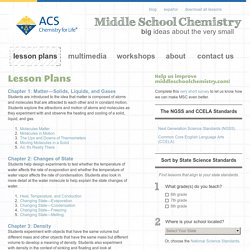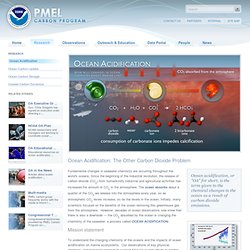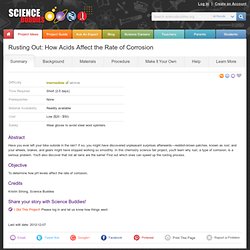

The Periodic Table: Crash Course Chemistry #4. Science 7 Chemistry Unit Outline. Chemistry - ACS Lesson Plans. Chapter 1: Matter—Solids, Liquids, and Gases Students are introduced to the idea that matter is composed of atoms and molecules that are attracted to each other and in constant motion.

Students explore the attractions and motion of atoms and molecules as they experiment with and observe the heating and cooling of a solid, liquid, and gas. Chapter 2: Changes of State Students help design experiments to test whether the temperature of water affects the rate of evaporation and whether the temperature of water vapor affects the rate of condensation.
Students also look in more detail at the water molecule to help explain the state changes of water. Testing Acids and Bases Lab. Classifying Substances Cards. Color Changing Milk of Magnesia. Place about 100 mL of Milk of Magnesia in a 500 mL beaker and dilute with tap water until the beaker is about half full.

Add about 10 mL of Universal Indicator. (The Universal Indicator will provide the sharp color change you see in the video). Remember that Universal Indicator will turn red on the far acidic end of the scale and dark blue on the alkaline side. Carbon Dioxide Can Make a Solution Acidic. Do a demonstration to show that adding CO2 gas to water can make the water become acidic.

Materials for the Demonstration Universal indicator solution Water 2 clear plastic cups Straw Teacher Preparation Make indicator solution for student groups Make a dilute universal indicator solution for this demonstration and for each student group by combining 625 mL water with 25 mL universal indicator solution. Pour at least 80 mL of this dilute universal indicator solution into a clean plastic cup for each student group. Note: Your local tap water is likely fine for the demonstration and activities in this lesson. If the indicator solution you make is not green, this means that your water is either acidic or basic.
If this happens, use distilled water, which is available in supermarkets and pharmacies. Ocean Acidification. Ocean acidification, or "OA" for short, is the term given to the chemical changes in the ocean as a result of carbon dioxide emissions.

Hawaii Carbon Dioxide Time-Series Hawaii Carbon Dioxide Time-Series Location of planned OA monitoring and research sites and affiliated NOAA labs. NOAA OA Research and Monitoring Map Fundamental changes in seawater chemistry are occurring throughout the world's oceans. Mission statement. WWF Magazine - The Circle: Ocean Acidification. Marine Life on a Warming Planet. The State of Washington is now trying to tackle the problem in new and inventive ways.

It has good reason to worry. Its economically important aquaculture industry specializes in shellfish, especially oysters. Shellfish are highly vulnerable to increased acidity, which kills them by preventing them from creating or maintaining their shells. Washington’s coastal waters are also polluted by urban and farm runoff, as well as an unusual regional threat: wind patterns that cause the upwelling of deep, nutrient-rich ocean currents loaded with carbon dioxide. The state’s plan — an offshoot of the National Shellfish Initiative created by the National Oceanic and Atmospheric Administration in 2011 — acknowledges that the only long-term solution to acidification is for the world to reduce industrial emissions of carbon dioxide, allowing the ocean to reach a less acidic equilibrium.
Gov. Pace of Ocean Acidification Has No Parallel in 300 Million Years, Paper Says. Periodic Table (Names and Symbols only) Elements & Periodic Table. Now we're getting to the heart and soul of the way the Universe works.

You know that a generic atom has some protons and neutrons in the nucleus and some electrons zipping around in orbitals. When those pieces start combining in specific numbers, you can build atoms with recognizable traits. If you have eight protons, neutrons and electrons, you will have an oxygen (O) atom. If you have seven protons, neutrons, and electrons, you will have a nitrogen (N) atom.
The atoms for each element are unique, even though they are all made of similar subatomic parts. Remember that 'atom' is the general term. As far as we know, there are a limited number of basic elements. With the tools you learn here, you can explore and understand the Universe. Since the launch of the site, we've been asked, "Why start with 18?
" (1) Electrons fit nicely into three orbitals. Chemistry Project Ideas. Log In|Create an Account All Results All Results Ask an Expert Blog Careers Project Ideas Resources Home Project Ideas Project Guide Ask An Expert Blog Careers Teachers Parents Students Support for Science Buddies provided by:

Cabbage Chemistry. Make Your Own pH Paper. Abstract This is a simple "kitchen chemistry" project about acid/base chemistry.

Scientists measure the acidity or alkalinity of a solution using a logarithmic scale called the pH scale. In this project you'll learn about the pH scale, and you'll make your own pH indicator paper using a pH-sensitive dye that you'll extract from red cabbage. You can use your pH paper to measure the acidity/alkalinity of various household solutions. From Dull to Dazzling: Using Pennies to Test How pH Affects Copper Corrosion. Please ensure you have JavaScript enabled in your browser.

If you leave JavaScript disabled, you will only access a portion of the content we are providing. <a href="/science-fair-projects/javascript_help.php">Here's how. Rusting Out: How Acids Affect the Rate of Corrosion. Please ensure you have JavaScript enabled in your browser.

If you leave JavaScript disabled, you will only access a portion of the content we are providing. <a href="/science-fair-projects/javascript_help.php">Here's how. </a> Abstract Have you ever left your bike outside in the rain? Rocketology: Baking Soda + Vinegar = Lift Off! Please ensure you have JavaScript enabled in your browser. If you leave JavaScript disabled, you will only access a portion of the content we are providing. <a href="/science-fair-projects/javascript_help.php">Here's how. </a> Abstract.